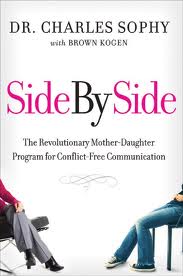Book Excerpt:
For many, motherhood is one of life’s greatest joys, but getting along with your children, particularly daughters, isn’t always a piece of cake. In “Side by Side: The Revolutionary Mother-Daughter Program for Conflict-Free Communication,” author Dr. Charles Sophy examines this family dynamic and how moms and daughters can have an open, loving relationship:
Introduction:
With all due respect, I often compare the mother-daughter relationship to being on a roller coas ter, the big, scary kind that you’re able to see from the next town over and whose passengers can be heard shrieking from miles away. Parts of that ride can certainly be thrilling and crazy fun, much like the way you may feel when you and your daughter are really getting along. There may be other stretches of that same ride that leave you feeling anxious, fearful, or nauseated — much like the way you may feel when you and your daughter are in the midst of an argument. There’s one big difference, though, between these two rides. Unlike the experience at the amusement park, the ride you are on with your daughter will never come to a halt, automatically release its safety bar, and allow you to exit. No matter how scary or intolerable the ride may get with your daughter, there’s not even a chance of getting off. This ride is forever. And there is no safety bar. The truth is, most moms don’t really want to get off this ride. They’d just prefer a slower, smoother, more predictable journey, a ride with fewer upside-down loops or steep, heart-stopping drops — one that doesn’t include, for example, your fifteen-year-old getting pregnant or your thirty-year-old becoming addicted to drugs. Nobody wants that ride. But it’s a given that every mother-daughter pair faces challenges, and it’s inevitable that at some point, there will be a challenge that will test the strength of this relationship and the ride will change.
ter, the big, scary kind that you’re able to see from the next town over and whose passengers can be heard shrieking from miles away. Parts of that ride can certainly be thrilling and crazy fun, much like the way you may feel when you and your daughter are really getting along. There may be other stretches of that same ride that leave you feeling anxious, fearful, or nauseated — much like the way you may feel when you and your daughter are in the midst of an argument. There’s one big difference, though, between these two rides. Unlike the experience at the amusement park, the ride you are on with your daughter will never come to a halt, automatically release its safety bar, and allow you to exit. No matter how scary or intolerable the ride may get with your daughter, there’s not even a chance of getting off. This ride is forever. And there is no safety bar. The truth is, most moms don’t really want to get off this ride. They’d just prefer a slower, smoother, more predictable journey, a ride with fewer upside-down loops or steep, heart-stopping drops — one that doesn’t include, for example, your fifteen-year-old getting pregnant or your thirty-year-old becoming addicted to drugs. Nobody wants that ride. But it’s a given that every mother-daughter pair faces challenges, and it’s inevitable that at some point, there will be a challenge that will test the strength of this relationship and the ride will change.
Variables like genetics, personality, socioeconomic status, and family history will certainly inform the way moms approach these issues, how heated these potential conflicts become, and of course how they’re resolved. However, aside from these variables, there is one significant factor that will give you and your daughter the best chance of negotiating these inevitable issues while maintaining an overall healthy and loving relationship: communication that is respectful and honest. This will not only ensure a safer ride, but will strengthen the bond between you and your daughter. This is our goal.
All mothers and daughters want the same things: love, understanding, respect. And they want them from each other. Mom wants love, respect, and understanding from the child she brought into the world. And daughter wants the same from the woman who gave her life. Many moms seek professional guidance because their daughter is acting out in some way — such as getting a tattoo, dressing inappropriately, or dating someone the rest of the family deems undesirable. The specific behaviors may be age related, but they are simply the manifestation of the underlying desire to be understood, respected, and loved. The only real way that the mother-daughter relationship can evolve in a healthy, loving, and sustainable way is to satisfy these needs. And it boils down to communication, which is something that mothers and daughters are doing constantly, just not as effectively as they could.
The fact that mothers and daughters often struggle is certainly not a novel premise; a vast number of books and periodicals have been written on the topic, all in an effort to comprehend this potentially volatile dynamic. But none of them have offered the straightforward approach found in this book. The truth is, there is something you, the mother, can do to improve your relationship with your daughter. You have a chance, a really good one, to make it better. A lot better.
It is up to you. Why? Because you not only are the designated driver of your family, you are essentially the one responsible for the existence of your daughter in the first place. Whether conceiving a child was a conscious choice, a mistake that you ultimately chose to celebrate, or a journey through fertility medicine, you made it happen! You hungered to have a child  and create a family, took the steps necessary to become pregnant or to adopt a child, and committed yourself to that mission. This in itself is a huge achievement. You may very well have a significant other who was part of that accomplishment — a husband, a boyfriend, a partner, an ex — and who remains part of your family unit as you journey through motherhood. If so, that person certainly has a role in the dynamic with your daughter. However, your relationship with your daughter must now be your exclusive focus. It is your responsibility to fully embrace the next challenge and figure out a better way to communicate with your daughter.
and create a family, took the steps necessary to become pregnant or to adopt a child, and committed yourself to that mission. This in itself is a huge achievement. You may very well have a significant other who was part of that accomplishment — a husband, a boyfriend, a partner, an ex — and who remains part of your family unit as you journey through motherhood. If so, that person certainly has a role in the dynamic with your daughter. However, your relationship with your daughter must now be your exclusive focus. It is your responsibility to fully embrace the next challenge and figure out a better way to communicate with your daughter.
Most moms, due to fear or lack of resources, feel as if there is nothing they can do to improve their relationship with their daughters. Yet there is a technique you can use that draws on resources you already possess. With this technique, I have been able to make a difference in the lives of thousands of mothers and daughters. I call it the Chair Strategy. This simple and effective mom-driven tactic begins with a visual image of the position of two chairs. Imagine that these chairs represent the way you and your daughter are communicating. Are they situated back-to-back, with the two of you in a deadlock, unable to see each other’s point of view? Are the chairs face-to-face, enabling each of you to share respectfully opposing viewpoints? Or are the chairs side-by-side, with the two of you working collaboratively to sustain your relationship? The answer to this question will enable you and your daughter to begin to understand how your communication efforts are succeeding or failing. The Chair Strategy will provide you with insight and tools to change the dynamic between the two of you, to more effectively resolve the conflicts that occur, and to emerge with an even stronger bond.
Whether your daughter is an infant or turns fifty years old tomorrow, whether the two of you talk several times a day or only sporadically, it is you, the mom, who must create an environment conducive to openness and true sharing. At this point, it doesn’t matter whether the two of you fight with harsh words or clenched fists. All that matters is that you begin the process of working toward a healthier and more loving dynamic with your daughter. It is in your hands.
I hope you appreciate the power and importance you have in the relationship with your daughter. This fact informs my basic philosophy: Parenting begins with you. Not your child. You.
To explain this concept, I often use the analogy of the oxygen masks on an airplane. How many times have you heard a flight attendant utter the reminder that in case of emergency, you must first secure your oxygen mask and then your child’s? In that context it makes perfect sense, right? When you’re thirty thousand feet in the air and there’s some kind of mechanical malfunction in the fight gear, you need to put your mask on first so you can keep breathing; only then can you help your child put on hers. So it is with moms and daughters here on the ground. Only after you are a balanced and secure woman can you model that kind of strength and security for your daughter. And as you embrace this philosophy, you will have an even more successful outcome with the Chair Strategy…
Buy Side by Side: The Revolutionary Mother-Daughter Program for Conflict-Free Communication
